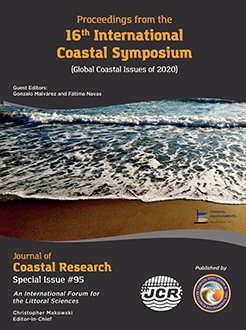Almar, R.; Bergsma, E.W.J.; Gawehn, M.A.; Aarninkhof, S.G.J., and Benshila, R., 2020. High-frequency temporal wave-pattern reconstruction from a few satellite images: A new method towards estimating regional bathymetry. In: Malvárez, G. and Navas, F. (eds.), Global Coastal Issues of 2020. Journal of Coastal Research, Special Issue No. 95, pp. 996-1000. Coconut Creek (Florida), ISSN 0749-0208.
It is currently impossible to accurately estimate coastal risks considering the lack of accurate and up-to-date bathymetric knowledge. We enter a new era of satellite coastal observation which offers unprecedented regional monitoring capabilities with a high spatial resolution. Methodologies to estimate bathymetry from waves developed for shore-based video camera systems are now widely used but require high frequency (several frames per second) and long duration (a few minutes) videos. Only a few satellite missions offer the possibility to acquire videos from space over regional domains (Pleiades persistent mode, WorldView-2). These are on-demand acquisitions at specific dates and generally expensive. At the same time, most of continuous Earth Observation missions, which have the potential to cover coastal evolution, offer short sequences using the different bands (2 to 10 bands within typically ∼1-2 seconds, e.g. Sentinel-2) or a sequence of a few images for stereo or tri-stereo topography purpose (2 or 3 images with lags of ∼8s, e.g. Pleiades). Here, we present how high-frequency wave pattern time-series can be reconstructed using a spatiotemporal cross-correlation, gathering surrounding sparse temporal wave information while conserving its high-resolution spatial information. This new methodology breaks several locks and enables deriving full wave characteristics from a limited number of images to quantify a robust regional bathymetry.





